Characteristics
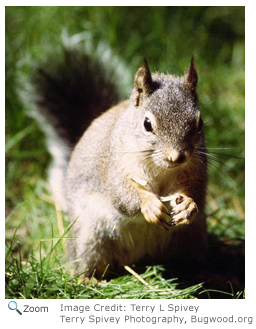 The Douglas squirrel is also known as the pine squirrel and the chickaree. It is reddish-brown on top and white or orangish-white on its undersides. The Douglas squirrel is also known as the pine squirrel and the chickaree. It is reddish-brown on top and white or orangish-white on its undersides.
In the winter its fur may be a little grayer. It has small ear tufts in the winter. It has very good eyesight and hearing.
Range
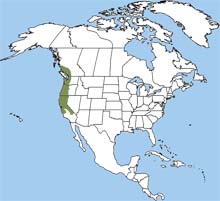 The Douglas squirrel can be found from south west British Columbia south to northern California. The Douglas squirrel can be found from south west British Columbia south to northern California.
Habitat
The Douglas squirrel lives in coniferous forests. | |
Diet
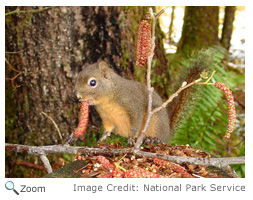 The Douglas squirrel eats pine seeds. In the fall, it cuts green pine cones from tree limbs and buries them in special piles called middens. The Douglas squirrel also eat acorns, berries, mushrooms and fruits. The Douglas squirrel eats pine seeds. In the fall, it cuts green pine cones from tree limbs and buries them in special piles called middens. The Douglas squirrel also eat acorns, berries, mushrooms and fruits.
Life Cycle
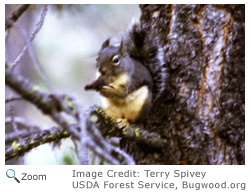 Mating season for the Douglas squirrel happens between late February and April. A little over a month after mating, the female gives birth to between four and six babies. The babies are born with their eyes closed and are hairless. Their hair will grow in a little over two weeks and their eyes will open in about a month. They are weaned after eight weeks. The young squirrels may stay with their mother for most of their first year. Mating season for the Douglas squirrel happens between late February and April. A little over a month after mating, the female gives birth to between four and six babies. The babies are born with their eyes closed and are hairless. Their hair will grow in a little over two weeks and their eyes will open in about a month. They are weaned after eight weeks. The young squirrels may stay with their mother for most of their first year.
Behavior
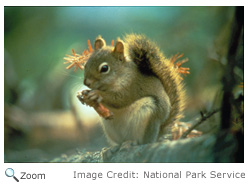 Douglas squirrels are very active during the day. They run in the trees and on the ground. When the weather is bad, they will stay in their nests. Douglas squirrels build summer nests of moss, lichen and pieces of bark and twigs. In the winter they make their nests in holes in trees. Douglas squirrels are very territorial and very vocal. Douglas squirrels are very active during the day. They run in the trees and on the ground. When the weather is bad, they will stay in their nests. Douglas squirrels build summer nests of moss, lichen and pieces of bark and twigs. In the winter they make their nests in holes in trees. Douglas squirrels are very territorial and very vocal.
|